Wujie Wen
A 10.60 $μ$W 150 GOPS Mixed-Bit-Width Sparse CNN Accelerator for Life-Threatening Ventricular Arrhythmia Detection
Oct 22, 2024



Abstract:This paper proposes an ultra-low power, mixed-bit-width sparse convolutional neural network (CNN) accelerator to accelerate ventricular arrhythmia (VA) detection. The chip achieves 50% sparsity in a quantized 1D CNN using a sparse processing element (SPE) architecture. Measurement on the prototype chip TSMC 40nm CMOS low-power (LP) process for the VA classification task demonstrates that it consumes 10.60 $\mu$W of power while achieving a performance of 150 GOPS and a diagnostic accuracy of 99.95%. The computation power density is only 0.57 $\mu$W/mm$^2$, which is 14.23X smaller than state-of-the-art works, making it highly suitable for implantable and wearable medical devices.
AdaPI: Facilitating DNN Model Adaptivity for Efficient Private Inference in Edge Computing
Jul 08, 2024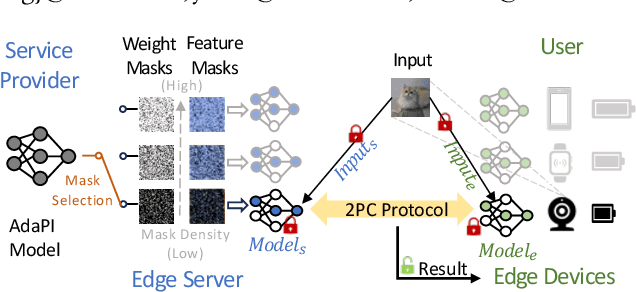

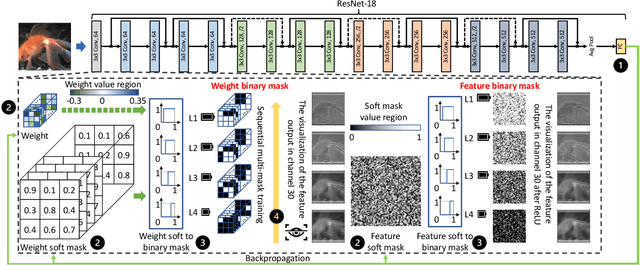

Abstract:Private inference (PI) has emerged as a promising solution to execute computations on encrypted data, safeguarding user privacy and model parameters in edge computing. However, existing PI methods are predominantly developed considering constant resource constraints, overlooking the varied and dynamic resource constraints in diverse edge devices, like energy budgets. Consequently, model providers have to design specialized models for different devices, where all of them have to be stored on the edge server, resulting in inefficient deployment. To fill this gap, this work presents AdaPI, a novel approach that achieves adaptive PI by allowing a model to perform well across edge devices with diverse energy budgets. AdaPI employs a PI-aware training strategy that optimizes the model weights alongside weight-level and feature-level soft masks. These soft masks are subsequently transformed into multiple binary masks to enable adjustments in communication and computation workloads. Through sequentially training the model with increasingly dense binary masks, AdaPI attains optimal accuracy for each energy budget, which outperforms the state-of-the-art PI methods by 7.3\% in terms of test accuracy on CIFAR-100. The code of AdaPI can be accessed via https://github.com/jiahuiiiiii/AdaPI.
SSNet: A Lightweight Multi-Party Computation Scheme for Practical Privacy-Preserving Machine Learning Service in the Cloud
Jun 04, 2024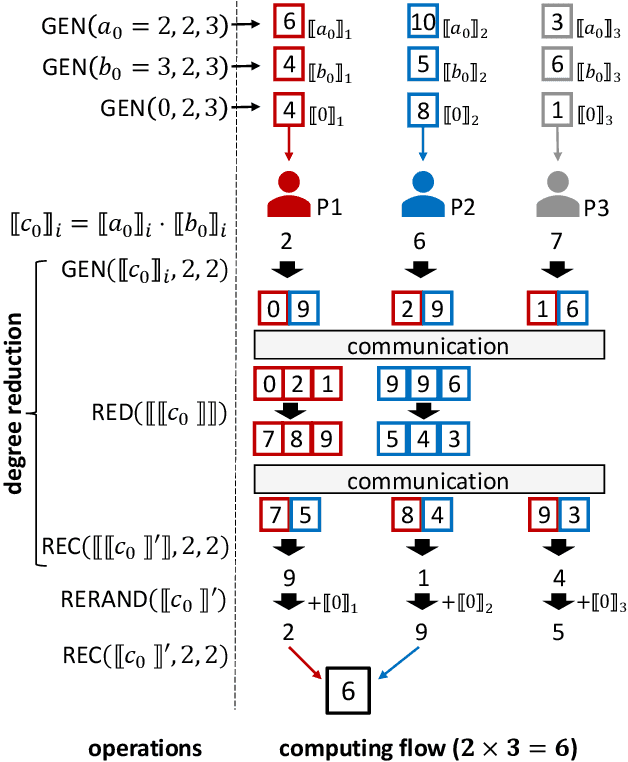
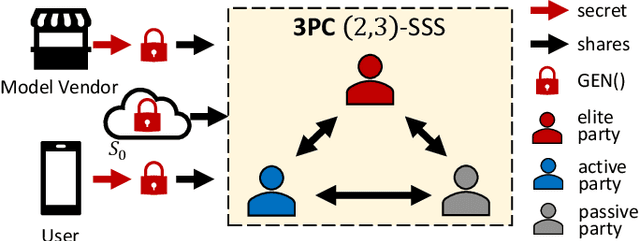
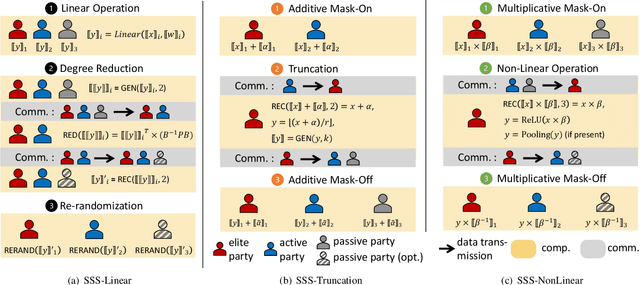
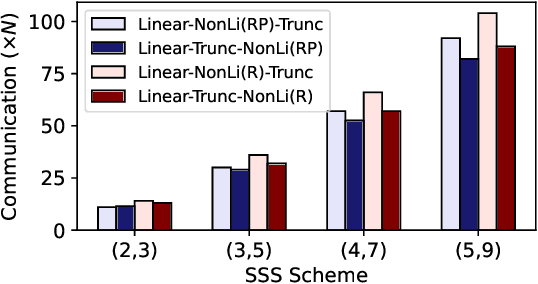
Abstract:As privacy-preserving becomes a pivotal aspect of deep learning (DL) development, multi-party computation (MPC) has gained prominence for its efficiency and strong security. However, the practice of current MPC frameworks is limited, especially when dealing with large neural networks, exemplified by the prolonged execution time of 25.8 seconds for secure inference on ResNet-152. The primary challenge lies in the reliance of current MPC approaches on additive secret sharing, which incurs significant communication overhead with non-linear operations such as comparisons. Furthermore, additive sharing suffers from poor scalability on party size. In contrast, the evolving landscape of MPC necessitates accommodating a larger number of compute parties and ensuring robust performance against malicious activities or computational failures. In light of these challenges, we propose SSNet, which for the first time, employs Shamir's secret sharing (SSS) as the backbone of MPC-based ML framework. We meticulously develop all framework primitives and operations for secure DL models tailored to seamlessly integrate with the SSS scheme. SSNet demonstrates the ability to scale up party numbers straightforwardly and embeds strategies to authenticate the computation correctness without incurring significant performance overhead. Additionally, SSNet introduces masking strategies designed to reduce communication overhead associated with non-linear operations. We conduct comprehensive experimental evaluations on commercial cloud computing infrastructure from Amazon AWS, as well as across diverse prevalent DNN models and datasets. SSNet demonstrates a substantial performance boost, achieving speed-ups ranging from 3x to 14x compared to SOTA MPC frameworks. Moreover, SSNet also represents the first framework that is evaluated on a five-party computation setup, in the context of secure DL inference.
Zero-Space Cost Fault Tolerance for Transformer-based Language Models on ReRAM
Jan 22, 2024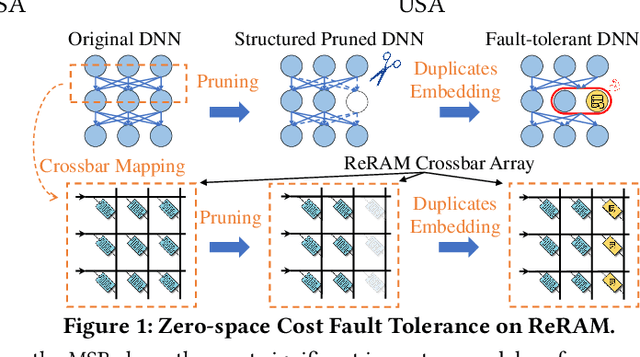

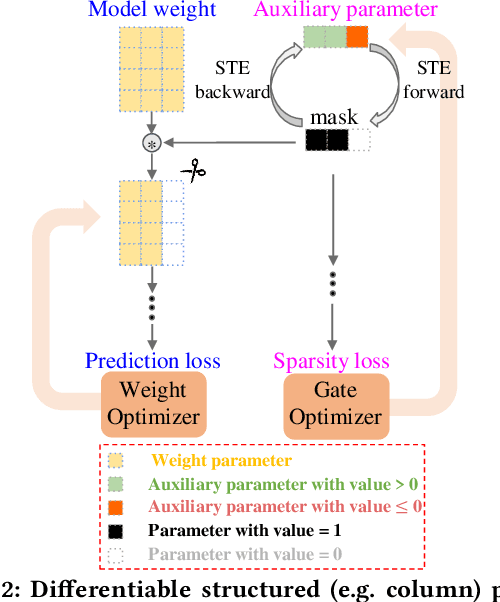

Abstract:Resistive Random Access Memory (ReRAM) has emerged as a promising platform for deep neural networks (DNNs) due to its support for parallel in-situ matrix-vector multiplication. However, hardware failures, such as stuck-at-fault defects, can result in significant prediction errors during model inference. While additional crossbars can be used to address these failures, they come with storage overhead and are not efficient in terms of space, energy, and cost. In this paper, we propose a fault protection mechanism that incurs zero space cost. Our approach includes: 1) differentiable structure pruning of rows and columns to reduce model redundancy, 2) weight duplication and voting for robust output, and 3) embedding duplicated most significant bits (MSBs) into the model weight. We evaluate our method on nine tasks of the GLUE benchmark with the BERT model, and experimental results prove its effectiveness.
LinGCN: Structural Linearized Graph Convolutional Network for Homomorphically Encrypted Inference
Sep 30, 2023Abstract:The growth of Graph Convolution Network (GCN) model sizes has revolutionized numerous applications, surpassing human performance in areas such as personal healthcare and financial systems. The deployment of GCNs in the cloud raises privacy concerns due to potential adversarial attacks on client data. To address security concerns, Privacy-Preserving Machine Learning (PPML) using Homomorphic Encryption (HE) secures sensitive client data. However, it introduces substantial computational overhead in practical applications. To tackle those challenges, we present LinGCN, a framework designed to reduce multiplication depth and optimize the performance of HE based GCN inference. LinGCN is structured around three key elements: (1) A differentiable structural linearization algorithm, complemented by a parameterized discrete indicator function, co-trained with model weights to meet the optimization goal. This strategy promotes fine-grained node-level non-linear location selection, resulting in a model with minimized multiplication depth. (2) A compact node-wise polynomial replacement policy with a second-order trainable activation function, steered towards superior convergence by a two-level distillation approach from an all-ReLU based teacher model. (3) an enhanced HE solution that enables finer-grained operator fusion for node-wise activation functions, further reducing multiplication level consumption in HE-based inference. Our experiments on the NTU-XVIEW skeleton joint dataset reveal that LinGCN excels in latency, accuracy, and scalability for homomorphically encrypted inference, outperforming solutions such as CryptoGCN. Remarkably, LinGCN achieves a 14.2x latency speedup relative to CryptoGCN, while preserving an inference accuracy of 75% and notably reducing multiplication depth.
AutoReP: Automatic ReLU Replacement for Fast Private Network Inference
Aug 20, 2023



Abstract:The growth of the Machine-Learning-As-A-Service (MLaaS) market has highlighted clients' data privacy and security issues. Private inference (PI) techniques using cryptographic primitives offer a solution but often have high computation and communication costs, particularly with non-linear operators like ReLU. Many attempts to reduce ReLU operations exist, but they may need heuristic threshold selection or cause substantial accuracy loss. This work introduces AutoReP, a gradient-based approach to lessen non-linear operators and alleviate these issues. It automates the selection of ReLU and polynomial functions to speed up PI applications and introduces distribution-aware polynomial approximation (DaPa) to maintain model expressivity while accurately approximating ReLUs. Our experimental results demonstrate significant accuracy improvements of 6.12% (94.31%, 12.9K ReLU budget, CIFAR-10), 8.39% (74.92%, 12.9K ReLU budget, CIFAR-100), and 9.45% (63.69%, 55K ReLU budget, Tiny-ImageNet) over current state-of-the-art methods, e.g., SNL. Morever, AutoReP is applied to EfficientNet-B2 on ImageNet dataset, and achieved 75.55% accuracy with 176.1 times ReLU budget reduction.
Improving Realistic Worst-Case Performance of NVCiM DNN Accelerators through Training with Right-Censored Gaussian Noise
Jul 29, 2023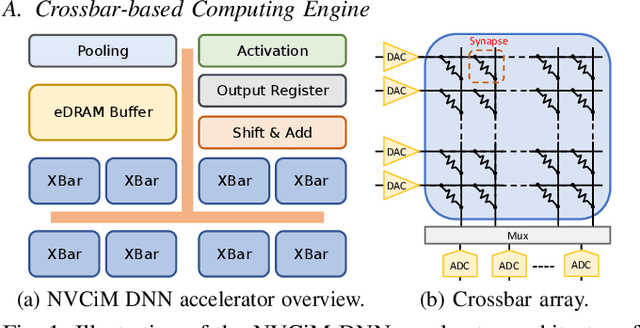
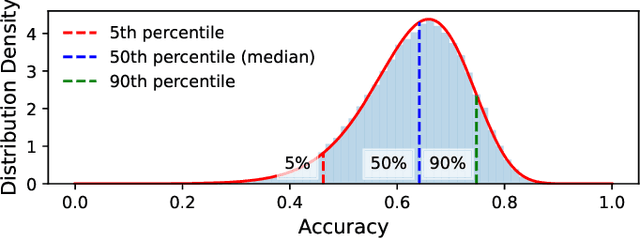
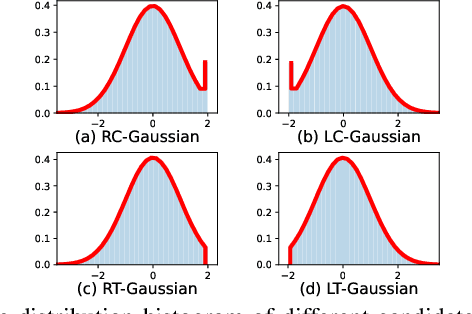
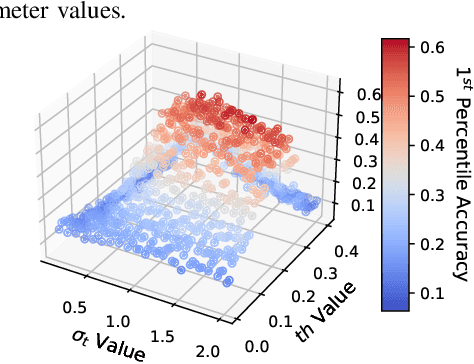
Abstract:Compute-in-Memory (CiM), built upon non-volatile memory (NVM) devices, is promising for accelerating deep neural networks (DNNs) owing to its in-situ data processing capability and superior energy efficiency. Unfortunately, the well-trained model parameters, after being mapped to NVM devices, can often exhibit large deviations from their intended values due to device variations, resulting in notable performance degradation in these CiM-based DNN accelerators. There exists a long list of solutions to address this issue. However, they mainly focus on improving the mean performance of CiM DNN accelerators. How to guarantee the worst-case performance under the impact of device variations, which is crucial for many safety-critical applications such as self-driving cars, has been far less explored. In this work, we propose to use the k-th percentile performance (KPP) to capture the realistic worst-case performance of DNN models executing on CiM accelerators. Through a formal analysis of the properties of KPP and the noise injection-based DNN training, we demonstrate that injecting a novel right-censored Gaussian noise, as opposed to the conventional Gaussian noise, significantly improves the KPP of DNNs. We further propose an automated method to determine the optimal hyperparameters for injecting this right-censored Gaussian noise during the training process. Our method achieves up to a 26% improvement in KPP compared to the state-of-the-art methods employed to enhance DNN robustness under the impact of device variations.
Spectral-DP: Differentially Private Deep Learning through Spectral Perturbation and Filtering
Jul 25, 2023



Abstract:Differential privacy is a widely accepted measure of privacy in the context of deep learning algorithms, and achieving it relies on a noisy training approach known as differentially private stochastic gradient descent (DP-SGD). DP-SGD requires direct noise addition to every gradient in a dense neural network, the privacy is achieved at a significant utility cost. In this work, we present Spectral-DP, a new differentially private learning approach which combines gradient perturbation in the spectral domain with spectral filtering to achieve a desired privacy guarantee with a lower noise scale and thus better utility. We develop differentially private deep learning methods based on Spectral-DP for architectures that contain both convolution and fully connected layers. In particular, for fully connected layers, we combine a block-circulant based spatial restructuring with Spectral-DP to achieve better utility. Through comprehensive experiments, we study and provide guidelines to implement Spectral-DP deep learning on benchmark datasets. In comparison with state-of-the-art DP-SGD based approaches, Spectral-DP is shown to have uniformly better utility performance in both training from scratch and transfer learning settings.
Negative Feedback Training: A Novel Concept to Improve Robustness of NVCiM DNN Accelerators
May 23, 2023Abstract:Compute-in-Memory (CiM) utilizing non-volatile memory (NVM) devices presents a highly promising and efficient approach for accelerating deep neural networks (DNNs). By concurrently storing network weights and performing matrix operations within the same crossbar structure, CiM accelerators offer DNN inference acceleration with minimal area requirements and exceptional energy efficiency. However, the stochasticity and intrinsic variations of NVM devices often lead to performance degradation, such as reduced classification accuracy, compared to expected outcomes. Although several methods have been proposed to mitigate device variation and enhance robustness, most of them rely on overall modulation and lack constraints on the training process. Drawing inspiration from the negative feedback mechanism, we introduce a novel training approach that uses a multi-exit mechanism as negative feedback to enhance the performance of DNN models in the presence of device variation. Our negative feedback training method surpasses state-of-the-art techniques by achieving an impressive improvement of up to 12.49% in addressing DNN robustness against device variation.
Neurogenesis Dynamics-inspired Spiking Neural Network Training Acceleration
Apr 24, 2023



Abstract:Biologically inspired Spiking Neural Networks (SNNs) have attracted significant attention for their ability to provide extremely energy-efficient machine intelligence through event-driven operation and sparse activities. As artificial intelligence (AI) becomes ever more democratized, there is an increasing need to execute SNN models on edge devices. Existing works adopt weight pruning to reduce SNN model size and accelerate inference. However, these methods mainly focus on how to obtain a sparse model for efficient inference, rather than training efficiency. To overcome these drawbacks, in this paper, we propose a Neurogenesis Dynamics-inspired Spiking Neural Network training acceleration framework, NDSNN. Our framework is computational efficient and trains a model from scratch with dynamic sparsity without sacrificing model fidelity. Specifically, we design a new drop-and-grow strategy with decreasing number of non-zero weights, to maintain extreme high sparsity and high accuracy. We evaluate NDSNN using VGG-16 and ResNet-19 on CIFAR-10, CIFAR-100 and TinyImageNet. Experimental results show that NDSNN achieves up to 20.52\% improvement in accuracy on Tiny-ImageNet using ResNet-19 (with a sparsity of 99\%) as compared to other SOTA methods (e.g., Lottery Ticket Hypothesis (LTH), SET-SNN, RigL-SNN). In addition, the training cost of NDSNN is only 40.89\% of the LTH training cost on ResNet-19 and 31.35\% of the LTH training cost on VGG-16 on CIFAR-10.
 Add to Chrome
Add to Chrome Add to Firefox
Add to Firefox Add to Edge
Add to Edge